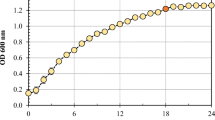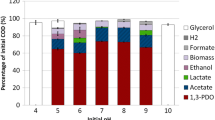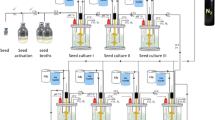Abstract
Three fermentable substances, glucose, 1,2-ethanediol and 1,2-propanediol were checked as cosubstrates for the fermentation of glycerol by Clostridium butyricum and Citrobacter freundii with the aim of achieving a complete conversion of glycerol to 1,3-propanediol. Glucose was fermented by C. butyricum mainly to acetate, CO2 and reducing equivalents in the presence of glycerol and contributed markedly to the 1,3-propanediol yield. However, because of relatively slow growth on glucose, complete conversion was not achieved. If the two glycols were used as cosubstrates for glycerol fermentation, the 1,3-propanediol yield did not increase but dimished considerably, as they were converted to more reduced products, i.e. alcohols instead of acids. From 1,2-propanediol 2-propanol was formed in addition to 1-propanol. The ratio of the propanols was dependent on the culture conditions.
Similar content being viewed by others
References
Azova LG (1967) Utilization of glycerol by some strains of butyric acid bacteria. Doklady Akad Nauk SSSR 172:1434–1435
Biebl H (1991) Glycerol fermentation to 1,3-propanediol by Clostridium butyricum. Measurement of product inhibition by use of a pH-auxostat. Appl Microbiol Biotechnol 35:701–705
Biebl H, Marten S, Hippe H, Deckwer W-D (1992) Glycerol conversion to 1,3-propanediol by newly isolated clostridia. Appl Microbiol Biotechnol 36:592–597
Forage RG, Foster MA (1979) Resolution of the coenzyme B12-dependent dehydratases of Klebsiella sp. and Citrobacter freundii. Biochim Biophys Acta 569:249–258
Forsberg CW (1987) Production of 1,3-propanediol from glycerol by Clostridium acetobutylicum and other Clostridium species. Appl Environ Microbiol 53:639–643
Gaston LW, Stadtman ER (1963). Fermentation of ethylene glycol by Clostridium glycolicum sp. n. J Bacteriol 85:356–362
Gottschalk G, Averhoff B (1988) Process for the microbiological preparation of 1,3-propandiol from glycerol. European patent no. 0 373 230 A1
Günzel B, Yonsel S, Deckwer W-D (1991) Fermentative production of 1,3-propanediol from glycerol by Clostridium butyricum up to a scale of 2 m3. Appl Microbiol Biotechnol 36:289–295
Hartmannis MGN, Stadtman T (1986) Diol metabolism and diol dehydratase in Clostridium glycolicum. Arch Biochem Biophys 245:144–152
Heyndrickx M, Vos P de, Vancanneyt M, Ley J de (1991) The fermentation of glycerol by Clostridium butyricum LMG 1212 t2 and 1213 t1 and C. pasteurianum LMG 3285. Appl Microbiol Biotechnol 34:637–642
Homann T, Tag C, Biebl H, Deckwer W-D, Schink B (1990) Fermentation of glycerol to 1,3-propanediol by Klebsiella and Citrobacter strains. Appl Microbiol Biotechnol 33:121–126
Hoshino K (1960) Studies on an organism producing isopropanol from acetone. Part V. Enzymological study on the oxidation-reduction of Lactobacillus brevis var. hofuensis (in Japanese). Nippon Nogei kagaku Kaishi 34:608–615
Mickelson MN, Werkman CH (1940) The dissimilation of glycerol by coli-aerogenes intermediates. J Bacteriol 39:709–715
Nakas JP, Schaedle M, Parkinson CM, Coonley CE, Tanenbaum SW (1983) System development of linked fermentation production of solvents from algal biomass. Appl Environ Microbiol 46:1017–1023
Schink B, Stieb M (1983) Fermentative degradation of polyethylene glycol by a strictly anaerobic, gram-negative, nonsporeforming bacterium, Pelobacter venetianus sp. nov. Appl Environ Microbiol 45:1905–1913
Tong I-T, Cameron D (1992) Enhancement of 1,3-propanediol production by cofermentation in Escherichia coli expressing Klebsiella pneumoniae dha regulon genes. Appl Biochem Biotechnol 34/35:149–159
Toraya T, Honda S, Fukui S (1979) Fermentation of 1,2-propanediol and 1,2-ethanediol by some genera of Enterobacteriaceae, involving coenzyme B12-dependent diol dehydratase. J Bacteriol 139:39–47
Tran-Dinh K, Hill, FF (1987) Verfahren zur Herstellung von Propan diol-(1,3). German patent no. DE 37 34 764 A1
Vasconcelos I, Girbal L, Soucaille P (1994) Regulation of carbon and electron flow in Clostridium acetobutylicum grown in chemostat culture at neutral pH on mixtures of glucose and glycerol. J Bacteriol 176:1443–1450
Author information
Authors and Affiliations
Rights and permissions
About this article
Cite this article
Biebl, H., Marten, S. Fermentation of glycerol to 1,3-propanediol: use of cosubstrates. Appl Microbiol Biotechnol 44, 15–19 (1995). https://doi.org/10.1007/BF00164474
Received:
Revised:
Accepted:
Issue Date:
DOI: https://doi.org/10.1007/BF00164474




